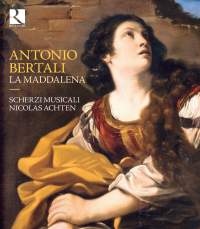Texte paru dans: / Appeared in: |
|
|
Outil de traduction ~ (Très approximatif) |
|
|
Reviewer: Barry
Brenesal Antonio Bertali was one of many Italian performers during this period who was attracted to the Viennese court of Ferdinand II (himself a serious, well-trained composer, as opposed to the likes of Henry VIII and Leo X). He became one of the Emperor’s musicians in 1624, where he was at first noted for his great skill at a violinist. His compositional and administrative abilities became evident over time, and he eventually took over as Kapellmeister in 1649, following the death of Giovanni Valentini. Like all the other occupants of his office he was extremely busy, maintaining an exceptional level of quality in performance as well as a seemingly endless succession of compositions: 33 masses alone, as well as eight Requiem Masses, 12 operas, a host of chamber and orchestral music, many cantatas, and five oratorios. The last include La Maddalena. It was composed in 1663 as a sepulcro, a work of sorrow, penitence, and regret meant to be heard (and possibly acted) during Holy Week. In contrast to the usual brilliant orchestration that was a part of the Ferdinand’s musical preferences, sacred as well as secular, La Maddalena was composed to largely dark musical colors in a six-part consort of viols, a violin, two muted cornetts, and a trombone. Bertali presents the aural equivalent of a three-part painted triptych: Repentance and Love of God grieve; the Virgin Mary, and Mary Magdalene implore Christ’s return, or ask to die; a pair of penitents join them, hoping and begging for forgiveness. Very short orchestral introductions contribute to the affective aspect of all three sections which, taken together, last just under 37 minutes on this recording. The Hapsburg Emperors of the 17th century maintained huge musical establishments, and were as extremely conservative in the arts as they were in politics. It thus isn’t surprising that the oratorio’s musical style mostly utilizes the heightened recitative familiar from Monteverdi’s various operatic scores. There is nothing sensuous here, but a darkly expressive lyricism without let. Which isn’t to say that lightness is abandoned altogether, only that it takes muted form—the slower triple time verse, “Ahi sospiri,” given first to the Virgin and then after a lengthy recitative to Mary Magdalene, finds some measure of solace in that the speaker ceases to repress their great sorrow through sighs. Or again, “Al lume giocondo,” sung by the two penitents, takes a lighter tone in contemplating, however briefly, the possibility of being forgiven. Given the oratorio’s short length, Nicolas Achten chose to use five musical selections composed for, and interpolated within, Giovan Battista Andreini’s 1617 sacred drama La Maddalena. It was a much more theatrically designed work and consequently more musically colorful, though a measure of Bertali’s compositional conservatism can be taken in the fact that Monteverdi’s Prologue would not feel out of place harmonically or structurally in the much later sepulcro. These are in turn followed by a sonata by Bertali; while the program concludes with Mazzocchi’s affecting Lagrime Amare—a lament for Mary Magdalene whose chromaticisms are the most extreme on the album. The performances are nearly all excellent. Achten’s own dry but exceeding agile baritone makes him an excellent Divine Favor in Monteverdi’s “Su le penne de’ venti,” its extravagant figures rendered perfectly, and with a dramatic emphasis that immediately draws and holds the attention. Of the other singers, Luciana Mancini, whose tone I once referred to as “acidulous,” here seems more lacking in resonance than anything less pleasant. It would appear to be a trait shared with Sönke Tams Freier, who lower notes also come close to vanishing under the light continuo accompaniment of the oratorio’s first section. At the other end of the scale are Reinoud Van Mechnelen’s gleaming tenor and Deborah Cachet’s bright, tightly focused lyric soprano, used with appropriate tonal and dynamic variety. (Her fluent ability with figures is also on display in Lagrime Amare, where she shares the spotlight with cornettist Lambert Colson.) The instrumental aspects of Scherzi Musicali are well in hand, and the engineering sounds both close and especially well defined. There is none of the over-reverberance used on occasion to make a small ensemble sound larger and richer, but good clarity between the parts, including the continuo. Achten hails La Maddalena as a “masterpiece,” a term I am very reluctant to apply to nearly anything. It is clear this isn’t marketing, however, but a genuine reflection of his feelings and thoughts of Bertali’s score, based on the obvious attention lavished on the work. I will go so far as to say it is an inspired work of continuously somber beauty, set off brilliantly by the shorter pieces of quality surrounding it. Performed with style and enthusiasm, it is well worth the purchase. | |
|
Support us financially by purchasing this disc from eiher one of these
suppliers.
|
|
|
|
|
|
Cliquez l'un ou l'autre
bouton pour découvrir bien d'autres critiques de CD |
|




